|
When homeowners design their own pool they often decide that they want to go a less traditional shaped pool in favor of something a little more imaginative. Nearly everything about a swimming pool can be customizable to reflect a families unique creativity. However, many pool owners have come to believe a myth that unqiuely shaped pools can not be covered with an automatic safety cover. Yes, an Auto Cover Can Protect Your Unique Pool Design If you own or are contemplating an irregular shaped pool, fear not. Nearly every pool regardless or the shape or the size can be protected by an automatic pool cover. Whether you want to choose your automatic cover before you install your pool or after there are options to make sure that your pool is tastefully and professionally concealed and protected. The Many Benefits of a Pool Cover Specialists Auto CoverFor many people the idea of owning an auto cover is a novelty. Some pool owners see automatic covers as a sort of luxury, but when one considers the many benefits it becomes apparent that automatic covers should really be considered a necessity. Increased SafetyBy creating a barrier between the surface and the pool's water, automatic safety covers impressively protect children and pets from slipping into deep waters. Energy SavingsBy leaving the swimming pool cover on your pool when not in use you’re conserving energy. When left open heat can escape the pool and into the atmosphere. Fifty to 85% of energy savings on annual pool heating bills can be attributed to the aide of pool covers. Decreased Environmental ImpactIn addition to energy saving pool covers reduce CO2 emissions from pool heating as much as 3-6 tons, reduces evaporation up to 95%,and helps eliminate the primary source of evaporative action. Increased Free TimeGeneral maintenance required to keep your pool free of debris is greatly reduced if the cover is left on when the pool is not in use, thus giving you more time to float and less time cleaning. Efficient Pool Cover Specialists Auto Covers for Every Type of Pool and SpaThe benefits of automatic pool covers are not limited to just in ground pools. An Automatic Cover can be applied to any type of pool or spa. If it holds water for recreational use, it can (and should) be covered. This includes spas, cement pools, fiberglass pools, and vinyl liner pools.  Written by Aaron SteeleAaron is the Digital Marketing Manager for Latham Pool Products. Prior to realizing his dream of working in the swimming pool industry, he spent many years in the software and advertising world as a pixel pusher and script junkie. Aaron is an avid guitar player, weekend novelist, in-home libation manufacturer (aka. Homebrewer) and travel enthusiast. He has lived in exotic locations, climbed Mt. Fuji, swam in the open ocean with sharks, backpacked across Europe, skied the Swiss Alps, dined with the Dalai Lama, survived in a far east jungle for a week with nothing but a poncho and a machete and is currently learning to play the Didgeridoo. All true.
0 Comments
Chelsea Mills, Jr. Landscape Designer 6-18-16 Sustainability, water features and outdoor kitchens are hot this summer!
Eco-friendly designs and planting are becoming more and more important as our climate is changing drastically. Sustainable gardens are a great way to do your part for our environment. Using drought tolerant plants will ensure you are not wasting water to constantly hydrate your garden. Incorporate an edible garden into your yard by planting fruits, vegetables and herbs. This is a fun way to source your produce, and the kids will love it! Water features are becoming increasingly popular in residential landscapes. You don’t have to spend the money on a pool or hot tub to create your own outdoor oasis. Try a bubbling rock or fountain to add water to your yard. The sound of the water is relaxing and can help to drown out the sounds of your neighborhood. Outdoor kitchens add a touch of luxury to your patio and barbecue area. Outdoor kitchens can be as simple as a stone counter and as complex as a wet bar and built in barbecue. Having an outdoor kitchen will have you entertaining outdoors well into the fall months! May 12, 2016 / by Will Cappiello While Latham offers a warranty package on all liners, there are a myriad of ways to continue to care for your vinyl liner that could ultimately extend its life and retain the benefits included with a lined pool. If you are a brand new pool owner or just considering a vinyl liner pool then this is a must read! So how long does a vinyl liner usually last?Typically, some last from 5 to 10 years and others that are in ideal settings and properly taken care of may just very well last over 15 years. Since you’ve made the investment, ensuring that you make the best of your investment will include properly caring for that vinyl liner. Here’s a list of best practices to make this happen. Caring For Your Vinyl Swimming Pool Liner 1. Keep Your Chemicals Balanced and Use the Proper ChemicalsThe chemical test kit that came with your pool is a valuable ally. This is probably the single most important step in extending your liner’s life. Improper use of chemicals and chemical imbalance can zap the life out of your vinyl pool liner in a hurry. 2. Take Care of the Exposed Top Edge of the Vinyl LinerThe most vulnerable area of your liner is the top 6 to 8 inches above the water line. This area is regularly affected by such things as scale, body oils, lotions and airborne contaminants that will cause it to dry out. It’s a great idea to use an approved cleaner that you purchase from your local pool store to clean the exposed edge at least once or twice a month. 3. Use Common SenseThis may seem like a no brainer, but you’d be surprised at the things we in the pool industry see that ruin vinyl liner swimming pools each and every day. Pool vacuum poles are not meant to be used as pole vaults, and vinyl liner swimming pools should never double as hockey rinks in the winter. Be smart about what you use both in your pool area and what goes directly into your pool for fun and games. Make sure that sharp objects, including pet claws, stay far away from your vinyl liner.  Written by Will Cappiello. Will Cappiello is the Product Director for Package Pools and Vinyl Liners at Latham. Although Will has worked in Construction and the Office Products industry, he can honestly say the Pool industry and the people in it are the best by far!
Feb 2, 2015 / by Kevin Losee
Automatic covers can be installed on a wide range of pools of varying shapes and sizes. Regardless of the automatic cover system type that is used, whether the tracks or mechanism are under grade or on top of the pool deck, there are a number of benefits that a homeowner will gain by adding an automatic pool cover to their swimming pool. SafetyThe first is Safety. Although an automatic cover doesn’t replace the need for adult supervision, it does give peace of mind knowing that there is another layer of protection between your loved ones and your swimming pool. Check to make sure your automatic cover system meets the safety standards that are outlined in ASTM Standard F1346-91. SavingsThe second benefit is Savings. Pool owners can see dramatic savings in the operating costs of their pool in the following areas by adding an automatic cover to their pool.
ConvenienceThe third benefit is convenience. When closed, an automatic pool cover will keep the pool much cleaner. This will give pool owners more time to enjoy the pool and less time cleaning and maintaining it. After all, the pool was built to be enjoyed. 
Written by Kevin LoseeKevin Losee is the product manager for Automatic Safety Covers for Coverstar, a division of Latham Pool Products. During his 12 years at Coverstar, he has worked as an automatic safety cover installer, operations manager, technical support / order entry manager, and product manager. When not focused on automatic covers, he enjoys tearing up the trail on his mountain bike.
Gunite and shotcrete are forms of pneumatically applied concrete, meaning they are sprayed on with a high-pressure air hose. Crews shoot the material over a reinforcing network of steel bars. As you research information on a potential new backyard swimming pool, you will often encounter the term “gunite.” What exactly is that anyway? Is it different from concrete? And what’s the deal with shotcrete—is that the same thing or something else? Gunite pools provide unparalleled levels of design flexibility and aesthetic quality. Let’s take a look at some basics about this material, how it’s used in pool construction, how close it is to shotcrete, and the great advantages that both gunite and shotcrete deliver. Three key elements unique to gunite pool construction Known for its dependable structural strength, gunite is a concrete blend of sand, cement, and water that’s applied through a high-pressure hose. Once it cures (dries), gunite becomes rock hard, forming a thick, solid structure. For decades, it has held a special place in swimming pool construction, where it is always paired with another strong building material—steel—as well as an interior finishing coat of plaster. After a hole is excavated for a new pool, crews install a network of steel bars, known as rebar. Carefully placed at specific intervals, these metal rods form a cage-like frame that extends throughout the entire stretch of the future pool, as well as the spa if there is one. Extra steel goes into areas requiring especially high levels of reinforcement, such as a deep end or free-standing raised wall. Set on concrete blocks, the cage is suspended several inches in the air so it does not touch the soil beneath it. This way, plenty of space remains to be filled in by fresh gunite material. With the steel backbone in place, the pool is ready for gunite. Crews spray the concrete blend at high velocity onto the steel across the entire pool, creating the dense pool floor and walls. Gunite is highly adaptable to the pool form; it produces flowing lines, various contours, depths, and shapes—all coming together in a cohesive, visually appealing structure. After the gunite properly cures, a third material is applied to complete a gunite pool: plaster. Composed of cement and marble dust, the smooth blend may also contain colored quartz aggregate for added durability and aesthetics. (For some pools, a high-end pebble plaster may be used.) Plaster is what actually waterproofs a gunite pool, and this final coating is what everyone sees as the pool’s gleaming interior surface. Other critical elements go into building a gunite pool, including tile, plumbing, electric, and perimeter coping. However, what sets gunite construction apart from other types of pool is the gunite, steel, and plaster. And what sets the completed project apart is the incredible durability and design versatility that this trio provides. Both gunite and shotcrete are used to build swimming pool shells—the rock-hard vessels that can withstand pressure from shifting soil and the weight of thousands of gallons of water.
What’s shotcrete—and what’s the difference between it and gunite? What’s most important to understand here is that both gunite and shotcrete are a form of concrete. Between the two, the term gunite is more widely used in reference to swimming pools. However, it’s worth nothing that gunite is actually a type of shotcrete. It’s true: Gunite is the offspring of shotcrete. The only variations between them are the preparation and a single ingredient: Gunite is a dry mix—with water added to it with a hose at the job site; shotcrete is a “wet mix” that’s blended up beforehand. Shotcrete also contains some gravel, whereas gunite does not. First, let’s look at building a pool with gunite. A truck or gunite rig brings a dry load of sand and cement to a job site. There, the material goes into a container called a hopper. From there, the material feeds it into a mixing system known as an auger. The auger feeds the dry gunite mix into a high-pressure hose. The hose has a nozzle and is operated by a professional known as a nozzleman. Using an additional separate line and tip that connects to the gunite hose, the nozzleman adds water to the dry mix as it exits the hose. Now the blended gunite mixture is wet and it’s ready to be applied to create a swimming pool. Now, turning to shotcrete: The material is composed of sand, cement, and pea-sized gravel. These dry materials go into a large truck with a huge, rotating barrel—you have probably seen these rather imposing-looking vehicles on the road before. The barrel, which also contains water, mixes the dry material with the liquid to produce a smooth blend that will be ready for use as soon as the truck arrives at the job site. As with gunite, a high-pressure hose is used to spray the shotcrete into the pool hole to create a solid structure. Don’t get caught up in the distinctions between the two materials. Again, both are concrete, and both will create tough, long-lasting pool shells. Around the country, reputable pool builders construct inground pools using either. Depending on where you live, you’ll find gunite pools, shotcrete pools or both. Due to various local factors, pool contractors often use one material over another. In some regions of the U.S., gunite is dominant; in others, shotcrete is more commonly used. Or the use of each might be more evenly split. Either way, it’s all good. What matters most, is both gunite and shotcrete are ideal for swimming pool construction. Both create solid, monolithic structures with superior durability and flexibility for any backyard design. Note: Because the term gunite is so widely used in discussions about pools, from here on, this article will simply use “gunite” when describing pools built from either gunite or shotcrete. Why gunite pools are so popular Because it’s so versatile for design and durable for longevity, gunite has long been the standard for both commercial and residential swimming pool construction. Millions of gunite pools across the country provide fun, fitness, relaxation, and visual appeal in residential backyards. Thousands more provide the same at motels, hotels, schools, universities, athletic facilities, and community home developments and associations. For a beautiful, enduring aquatic upgrade, homeowners almost always prefer a pool built in concrete over other kinds. Fiberglass and vinyl liner pools may allow for quicker installation, lower initial cost, and limited choices for design. However, when it comes to the finished product, they fall way short of their gunite counterpart. With gunite, options for pool design cross the full spectrum. Whether building pools with smooth curves, sharp angles, or both, gunite delivers. From beach entries to elevated spas, a myriad of design features can be added to boost your pool’s overall style and beauty. You can have a private aquatic resort in virtually any size, shape, depth, and configuration that works best for your budget, backyard, lifestyle, and style preferences. —Built to last Along with distinctive style and ultimate design flexibility, there’s another reason that gunite is so widely used for pool construction. Gunite provides an enduring result: a stable, steel-reinforced concrete structure that holds water and stands the test of time. Gunite’s proven track record spans decades and all parts of the country (and globe). The key to its performance lies in its tensile strength—its ability to endure external force until it is compromised. Along with boasting an extremely high tensile fortitude, gunite brings something else to the table: flexibility. That’s right, being flexible makes gunite perform even better in a swimming pool. The reason comes down to dirt—that is, shifting ground. Never entirely static, soil under and around a pool moves in place. It contracts and expands from factors like compaction, water intrusion, freezing and thawing, and dry conditions like drought. And of course, soil changes occur from earthquakes—even tiny ones we do not realize ever happened. The lesson here is that a pool shell needs to “give” and be able to “go with the flow.” The structure—as tough and solid as it is—must have a dual personality so it can move and expand—and do it all without cracking! It’s this twin-set of attributes that makes gunite a superstar. The gunite shell can handle the pressure that most any backyard can dish out. After all, it’s not a coincidence that in California—earthquake country—hundreds of thousands of homes have pools that are gunite. The same goes for commercial pools. There’s a reason it’s rare to see any pool besides gunite at a hotel or resort. Businesses that own and maintain these properties know what works best and provides the most value. They need facilities that can be used by scores of guests and still hold up their appearance, safety, and durability. July 19, 2016 Jesse Land With hidden lakes, coursing waterfalls, fresh local fare and more, Michigan’s Upper Peninsula is a traveler’s ultimate escape. Featured blogger Jesse Land from Things to Do in the U.P. tells us about eight cool things he has done in the Eastern U.P. to inspire your visit. Many people forget just how big the U.P. is. For example, even though I live in Iron Mountain (roughly in the middle of the Upper Peninsula), it still takes me over four hours to get to DeTour, in the far eastern U.P. If I lived in Ironwood, it’d be more like a six hour drive! And so it is that the far ends of the U.P. often don’t get as much attention as they should. Well, I decided to at least scratch the surface in the eastern U.P. last summer and am so glad I did. Let me just point out that this is not a “best of” list by any means. One could easily spend a few weeks over in the Eastern U.P. and not take it all in. These are just a few highlights from last summer and hopefully by the time you’re done reading this you’ll want to venture over there to check it out for yourself! 1. Kayak through the Les Cheneaux Islands One of the highlights from last summer was definitely kayaking through a few of the Les Cheneaux Islands with Woods and Water Ecotours. Our guide Carla was a very experienced kayaker and had moved from out west to the Les Cheaneaux area to attend their famed wooden boat building school. Carla took my wife and I and two other travelers out around a few of the thirty six islands, over some really cool rock formations and even over a shallow water shipwreck. The short paddle was just long enough for me to realize I need to plan a whole week or more in the Les Cheneaux area with my kayak. What an amazing place. 2. Have lunch at Brown’s Fish House in Paradise Ah, Brown’s. It almost seems to good to be true. For some reason I’m afraid that one of these times I’m going to go into Brown’s Fisheries Fish House for lunch and not have an amazing meal. Luckily, that’s never happened and I doubt it ever will. Last summer I had their lake trout basket for the first time and I think I might have found a new favorite. If you like fresh fish, put Brown’s at the top of your U.P. itinerary. (32638 West M28 Paradise, MI) 3. Visit Tahquamenon Falls (and have dinner at the brewery) What’s a trip to to the eastern U.P. without a stop at Tahquamenon Falls? I had the chance to not only see the falls, but have a great chat with Lark Ludlow, the co-owner and brewer at the Tahquamenon Falls Brewery. Lark’s grandfather gifted much of the land that is now Tahquamenon Falls State Park to the state of Michigan so she told my friends and I about the history of the area, what used to be where the restaurant/brewery is now and how the brewery came to be. And we capped off the evening with an excellent dinner. Next time you visit Tahquamenon Falls, make sure to stop in the brewery! Even if you’re not a fan of craft beer, they’ve got great food. 4. Discover Malloney’s Irish Pub in Sault Sainte Marie We’d planned to visit the locally famous Antlers for dinner in Sault Sainte Marie, but ended up walking into to Maloney’s Alley Irish Pub just to check it out and were very pleasantly surprised, so we stayed for dinner. Prior to that visit I hadn’t heard of Malloney’s, but they ended up having great food and a terrific Michigan craft beer selection! I’ll definitely be back. (227 W Portage Ave. Sault Sainte Marie, MI) 5. Have a picnic lunch at the Hessel marina Sometimes it’s the simple things you remember the most. My wife and I packed a cooler for a picnic lunch on our first visit to the eastern U.P. last summer but didn’t have any specific location in mind. Well, we ended up finding the perfect spot as soon as we pulled into Hessel, in the form of the Hessel marina. We had lunch on a picnic table while gazing at antique wooden boats, water, a beach and the many islands as a few “islanders” came and went in their boats. Whether you have lunch here or not, it’s a great spot for a photo op. 6. Tour Drummond Island on ATV Another highlight was touring Drummond Island on ATV with Beaver’s ATV Rentals. We were told that Bill Beaver knows Drummond Island as good as anyone, and he sure seemed to. Bill led my wife and I on an excellent several hour tour of various Drummond Island highlights via the island’s designated ORV trails. And once again, it was enough to make us realize we need to block off at least a few days to explore Drummond Island further. We can’t wait to get back. 7. Visit Soo Brewing While in the Soo we made it a point to stop into Soo Brewing and really enjoyed the place. It’s an open, unassuming space with plenty of board games on hand and lots of couch and table space where friends can relax for hours. And since it’s located right downtown, it’s easy to walk from the brewery to all the other bars, restaurants and things to do in the area. 8. Visit the Crisp Point Lighthouse The Crisp Point Lighthouse is one of those places I’ve always wanted to go but for one reason or another I just wasn’t able to make it work. Well, last summer I was determined to get out there and am definitely glad I did. It’s probably the U.P.’s most remote lighthouse (at least that I’ve been to) but wow, what a place. It has a wonderful history, is beautifully restored and the view from the top is amazing! So, those are just eight of the cool things I did in the Eastern U.P. last summer. I can’t wait to get back there so I can add to this list for next year! What are some of your favorite things to do in the Eastern U.P.?  Jesse Land owns Land Family Media and publishes the Upper Peninsula Travel blog Things to do in the U.P. July 26, 2016 Pure Michigan Engineer’s Weekend in Sault Ste. Marie is the last Friday in June. There’s something for everyone, historic open houses, spectacular vistas and the opportunity to get a behind-the-scenes look at the great Soo Locks. Check out these nine interesting facts about the Soo Locks to inspire your visit from Sault Ste. Marie Convention and Visitor’s Bureau. A man-made marvel and the busiest lock system in the world, by cargo tonnage, yes the Soo Locks! On average, between seven and ten thousand ships come through the locks during the shipping season each year. Built in 1855, these locks connect Lake Superior to Lake Huron and beyond. We have repeat visitors every season; they call themselves Boat Nerds, that watch ships from all over the world use this free lock system. Now here are some facts about the locking system and the St. Marys River. $500.4 Billion value attributed to the iron ore shipped through the Soo Locks each year. An average of 80 million tons of cargo moves through them each year. 7,000 passages each year – Crews at the Soo Locks complete these lockages during the 42- week- long navigations season. They are open 24 hours a day. Can you take your personal boat through the locks? Yes, as long as you have a motor and permission from the lockmaster. 2,342 miles- ships from all over the world visit this port as the locks are a part of the Saint Lawrence Seaway, which connects Duluth, Minnesota to the Atlantic!
22 Million gallons of water to lift a boat. The locks are powered by gravity itself! Water moves in and out of the lock chambers by just opening and closing valves. 1000 foot boats- There are 13-1000 footers on the Great Lakes, and the largest boat that comes through the Soo Locks is the Paul R. Tregurtha, in at 1013 feet 6 inches which is larger than three football fields! The first vessels on the great lakes were 40 foot-long canoes. 9 hours between Lake Superior and Lake Huron, it takes a freighter about nine hours to pass through the St. Mary’s River system 21 foot drop- A thick layer of bedrock holds back the waters of Lake Superior where it joins the St. Marys River. This drop prevented boats from passing through. This reddish sandstone lines most of Lake Superior southern shores and is about 1000 feet-thick. The Fairbanks Scale Company, which is still in business today, built the first permanent lock, State Lock. 3-4 cents per ton- From 1855 to 1881, this was the toll, but today it is free. The propeller in Soo Locks Park is from a steamer named the Independence, which exploded just northwest of today’s locks. One crewman is said to have survived a trip down the rapids on a hay bale from the ship. Now that you know more about the Soo Locks, come and visit us during Engineer’s Weekend, when you can go into the locks and get up close and personal with this engineering marvel! Can’t make it that one day of the year? You can visit the Soo Locks Park anytime between late March and Mid-January to see the freighters go through the locks. Engineer’s Day is always the last Friday in June, which falls on the 30th in 2017. See what Engineer’s Weekend is all about in the video below. 8-12-16 Patrick Doyle Doyle Pools is introducing our E.A.S.Y in-ground pool kit. E-Our experienced Designers, Project Managers and Builders will EDUCATE you about the entire pool construction process and all the options available. A-We will ADVISE you on the best products and contractors options. S- We will help you to SOURCE all your material needs. Y- This entire process is designed with YOU and YOUR needs in mind. Would you like to have an in ground pool at a huge discount? Are you organized and able to follow simple instructions? Doyle Pools is making an incredible offer of a unique opportunity. It’s becoming more and more poplar that people are buying in-ground pool kits through online sources for a DIY project and saving A TON of MONEY!! The problem with DIY in-ground pool installation is a lack of experience and not knowing the tricks of the trade. This inexperience can COST you a lot headaches some of which include lost TIME due mistakes from lack of installation experience that can cause the project to take 4 weeks as opposed to taking only 3-5 days. This could mean unexpected days off work, use of family FUN FREE nights, and weekends that you could be spending enjoying the outdoors. It could EVEN mean having to replace your brand new unused liner, because of an incorrect cut. Or even the cost of replacing other portions of your pool kit due to damage during your DIY build. Doyle Pools’ program ensures that you don’t have those unexpected and potentially expensive issues. Here’s how you can SAVE your precious MONEY and TIME. Traditionally pool builders are no different than home builders. We fill three common roles; supplier, general contractor, and skilled tradesman. All of which come to you at an additional cost above what you would be able to hire them for yourself. The reason for this additional cost is to cover the contractor’s time involved in organizing, providing labor, and managing the entire project. At Doyle Pools we are seeing a trend in pool kits being purchased by the homeowner over the internet as a DIY projects. We are also seeing COSTLY mistakes being made in the project. Generally pool builders will not build something that they didn’t supply. Our philosophy is different. We believe that if we combined your DIY skills with our experience, everyone wins. Below you will see that we have created an a la carte system to assist you in the installation of your DIY pool project if you so choose. Some individuals will never consider this concept for their own reasons, and we are happy to handle the complete project, but for YOU who are willing to take on a little extra work and responsibility to have the opportunity save money, this is perfect. Everyone deserves a great outdoor space, and if we can help make that dream a reality, we’ve accomplished our mission. Here’s how it works
The balance of the project is yours to complete, but you’re not on your own. We will help you with as much or as little as you need. We can give advice or complete portions of the project that you are not comfortable with contracting out or doing yourself. The completion of excavating, electrical, and masonry will be charged on an a la carte basis by Doyle Pools. We also have a complete design service (special designs for an additional fee) available for you and your subcontractors to work from. Have Doyle Pools do as little or as much as you would like.
CALL NOW FOR DETAILS!! THIS IS A LIMITED TIME OFFER!! 11/20/2013 Scott Morris In recent years the use of phosphate removers in swimming pools has been a hot topic and the subject of much debate. Here’s a little background on the subject. Phosphates are a biological building block that nourish and promote the growth of plants – including algae. Phosphates are present in all natural water, which obviously includes the water in your swimming pool. The idea behind phosphate removal products is that less phosphates in the water will mean less algae. The question then becomes – do these products really work? To be honest, the effectiveness of these products is debatable. There is one school of thought that says phosphates in pool water are not a concern unless they exceed 1000 parts per billion (ppb). The other side of the debate says that phosphate levels should be kept to a maximum of 125 parts per billion. Obviously, there is a huge difference between those two numbers.
My opinion on the matter is that using a phosphate removal product in your pool water is perfectly fine – as long as you follow the package directions on your pool water testing kit and don’t go overboard trying to get your levels way down. However, I must say that I found the results of a recent study on this subject done by McGrayel Water Technologies to be quite interesting. The study involved two one-quart glass jars of water. One jar was filled with distilled water (which contains zero phosphates). The other jar contained water with 1000 ppb phosphate added. The jars were set out side by side in indirect sunlight for seven to eight days. In repeated tests, both jars of water grew the same amount of green algae. You can draw your own conclusions from this, but my opinion is that if your water contains less than 1000 ppb phosphates, you probably don’t need a phosphate removal product. However, if you want to use these products there is no harm in doing so – other than the added expense.
You’ve got your custom in-ground pool in your mind’s eye, and it’s gorgeous. It’s a work of art that could easily stand alone as a fabulous focal point for your backyard. But as long as you’re going to invest in a luxury swimming pool, why not go all the way and enhance the beauty of the surrounding area with an amazing deck?
Here are 10 pool/deck combinations that we think are beautifully unique.
Eye-Catching Ovals
We love how the curving deck surface mimics the oval shape of the pool. The thermal finish bluestone coping goes well with the blue pebble sheen finish of the pool.
From Walls to Water’s Edge
Here the wood siding of the house is continued out onto the pool deck for a very cohesive look. The wood decking is mahogany timber. Its rich colors contrast with the pool’s white tile coping.
Weathered Wood
The grayed decking is the perfect complement for a pool that looks out on the ocean. The rustic planks, minimal coping, and stainless steel cable railing (to maximize the view) come together in a style that is the definition of “simple beauty.”
Creative Shapes and Contrast
Deep, rich wood tones, contrasting light stone, and a very unique pool shape put this space on our list. The decking is a strong, durable wood called ipe (pronounced e-pay), which is similar to teak and is naturally a deep brown color with amber and red hues. The walkway and coping are limestone.
The Natural Look
We love the unusual markings on the stone pavers. Set them beside a kidney shaped pool and a stone backdrop amid anabundance of greenery and you’ve got a winning combination. The decking and coping are bullnose Norumbega Stone, which is also called Heritage Valley Stone. A great look with the medium gray finish of the pool.
Traditional with a Modern Touch
The integrated spa adds a modern feel to this traditional rectangular pool. The coping is thermal finish bluestone, as is the decking. The decking pattern, which uses a handful of different size pavers, is often referred to as Roman or French.
Dark Tone Drama
The slate gray stone decking creates a dramatic look. And who wouldn’t love to hop out of the pool after a cool evening swim and get cozy by the fire? The pavers and coping are “select blue” thermal finish bluestone nicely outlined by white tile grout.
Simply Shady
The simple stone surrounding the pool is beautiful, and we really love how the wood shade structure juts out into the water. The decking and coping are beige concrete pavers that look great with the light blue pool finish.
Pale Perfection
Don’t forget your sunglasses when you’re lounging around this pool. Its elevated position, light blue pool finish, and light-colored tumbled travertine deck and coping create a design you might say is “brilliant.”
Subtle Surround
The subdued color palette for the materials surrounding the pool make its blue/green color all the more vivid. The pool deck is a warm gray shade of integral color concrete, and is scored. The coping is a precast concrete product.
Endless Options
Of course these are just some of the great ways that a pool and deck can complement one another. The point of this short list of suggestions is simply to get the creative juices flowing as you install or upgrade your pool and/or deck. Give it some thought and then go transform that space into something special.
|

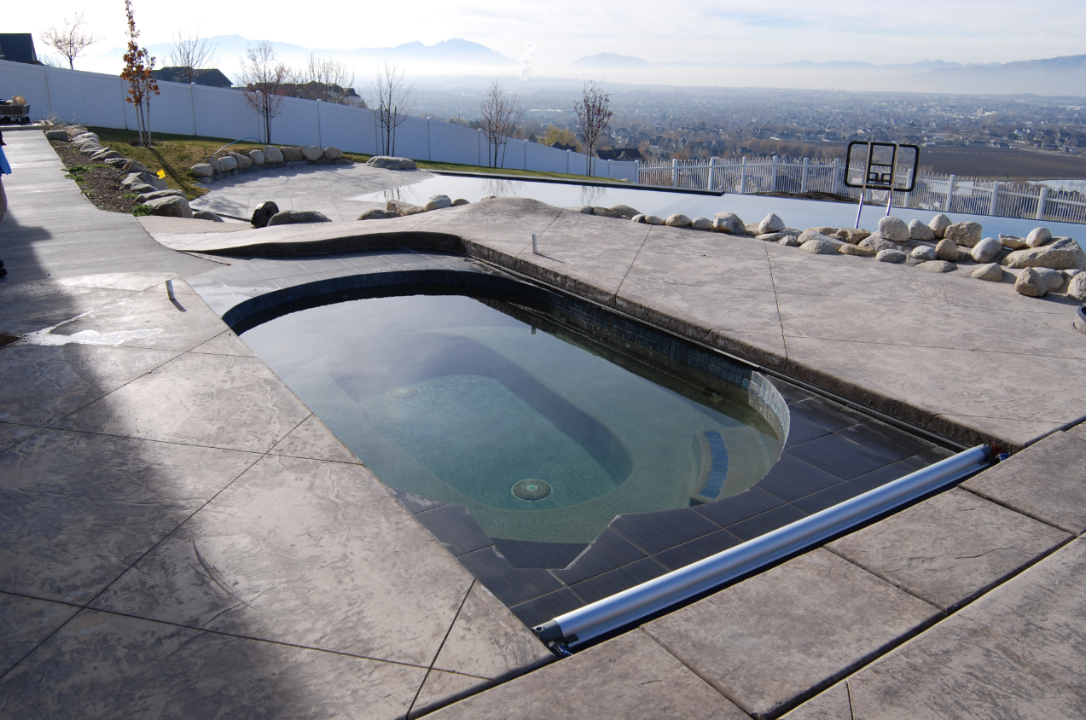
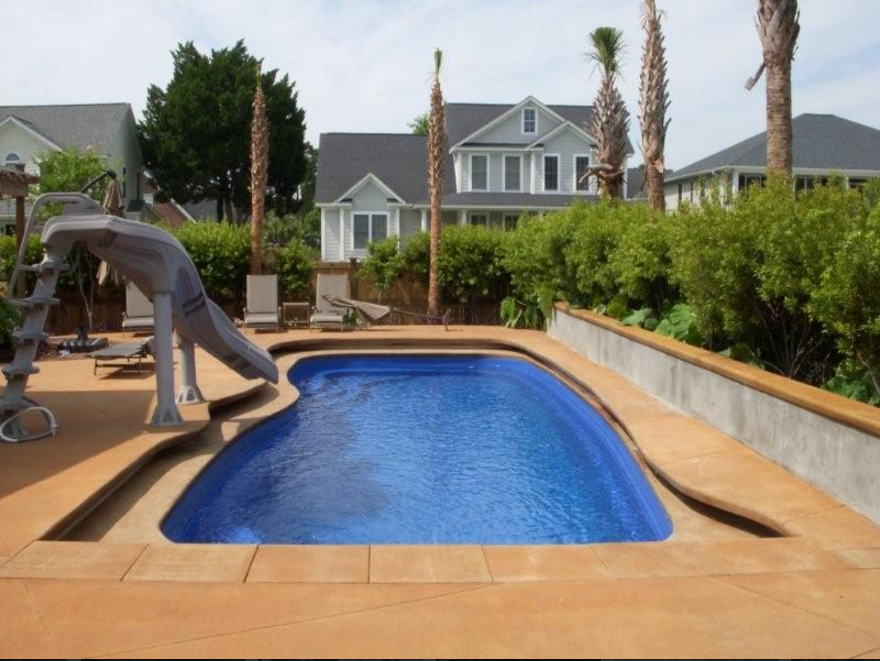
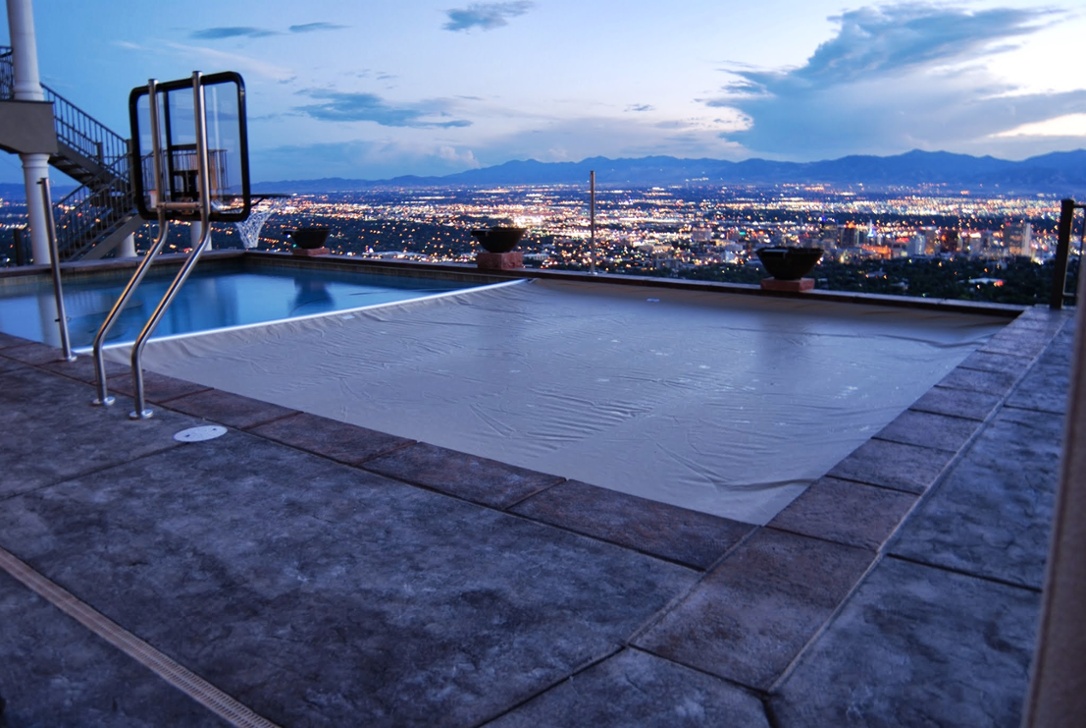
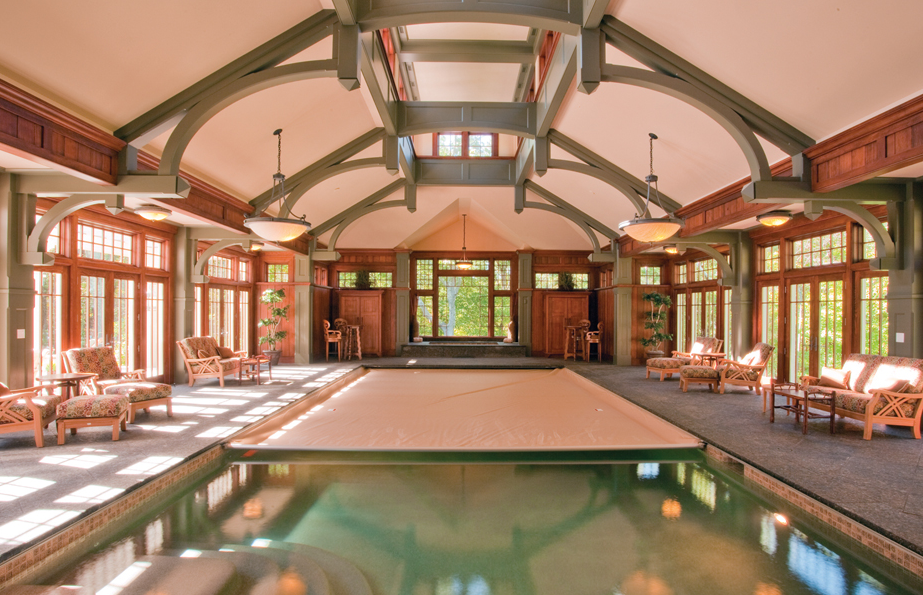
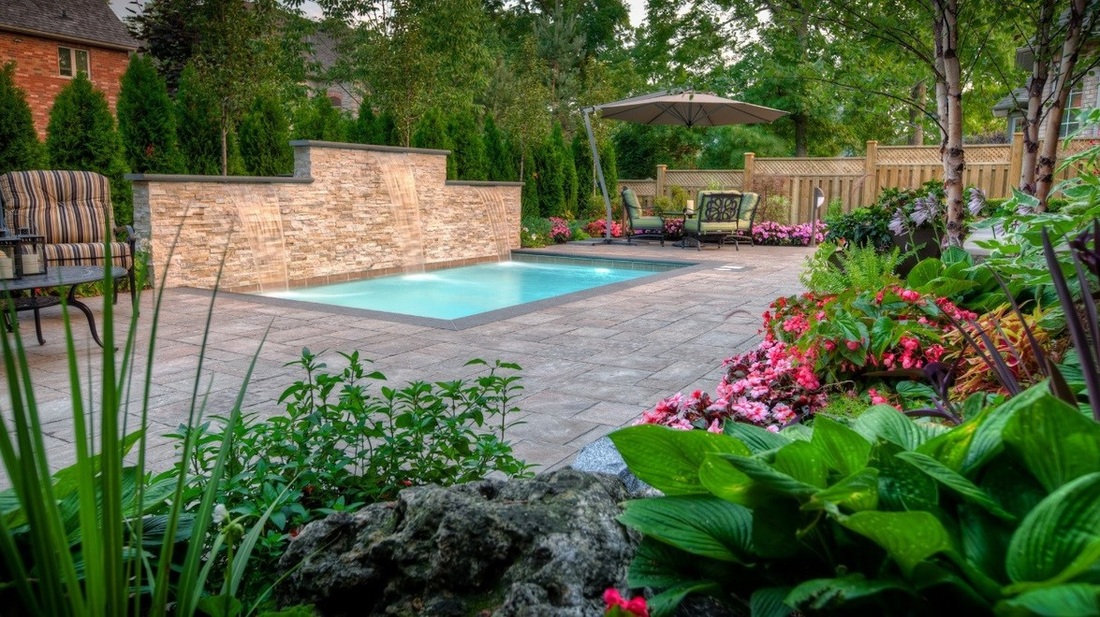
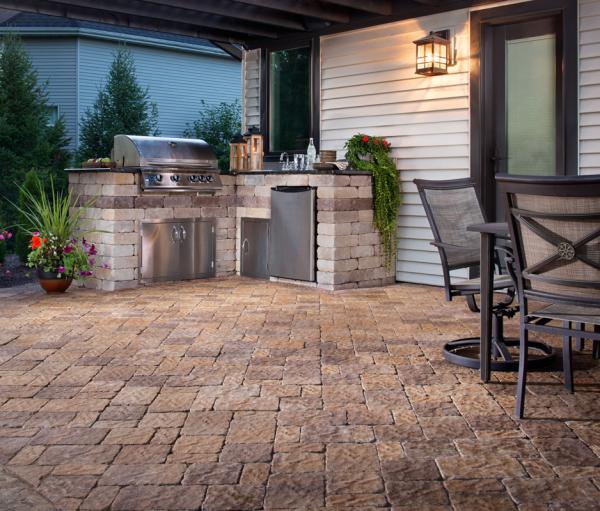
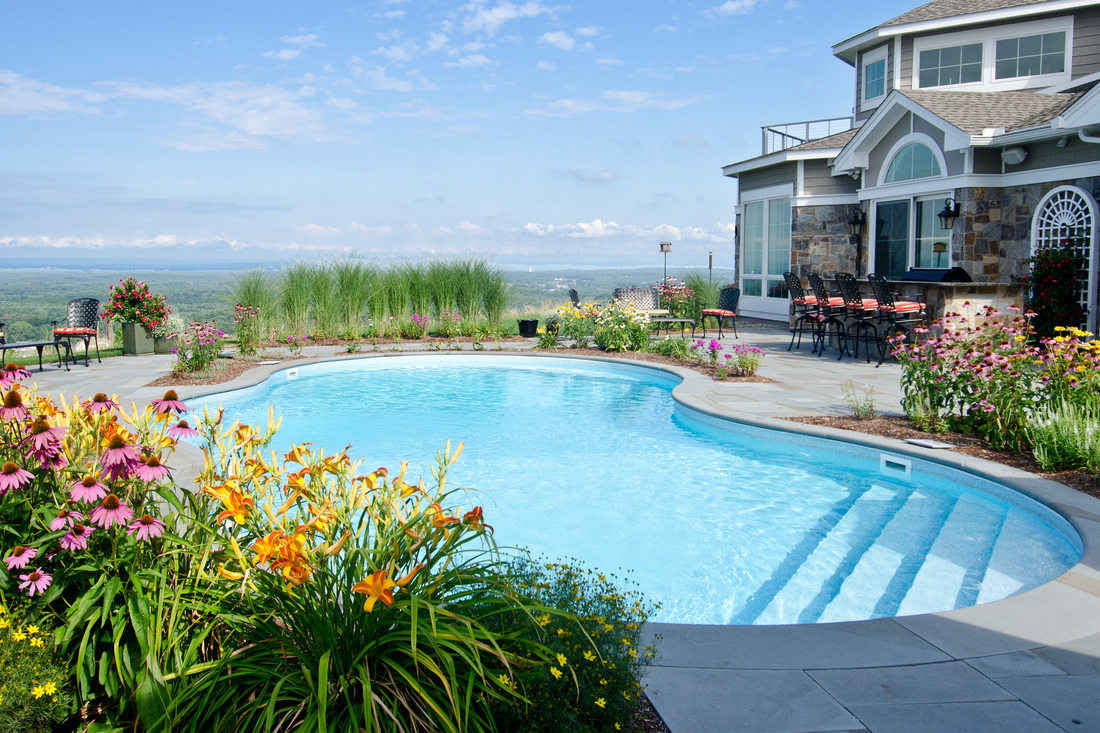
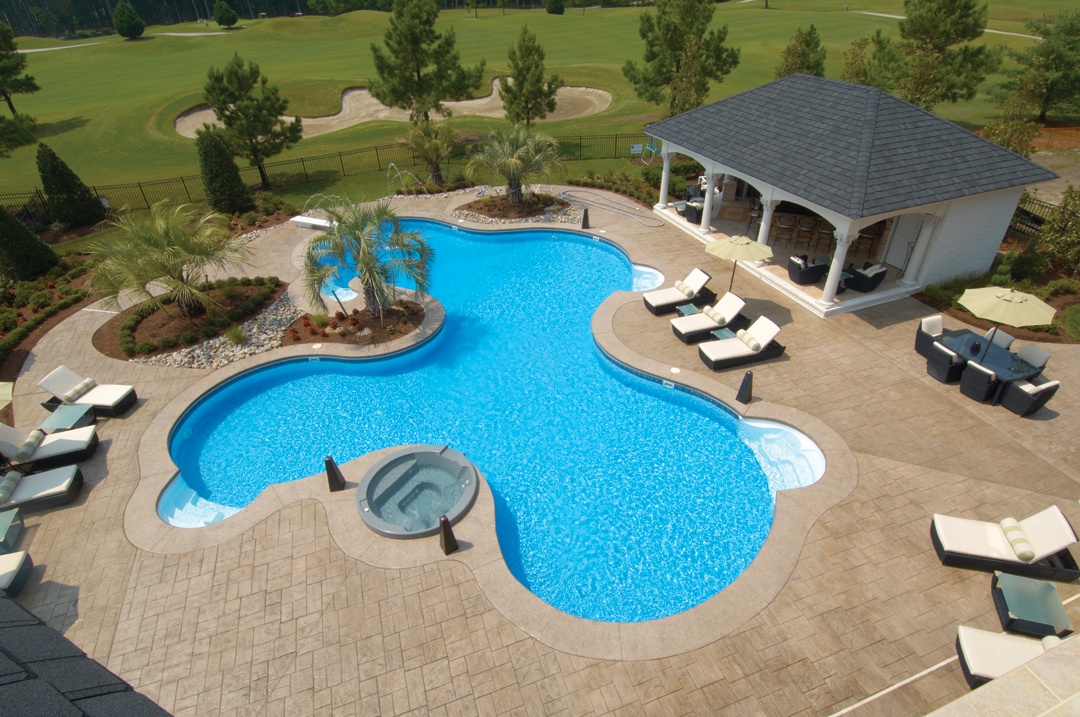
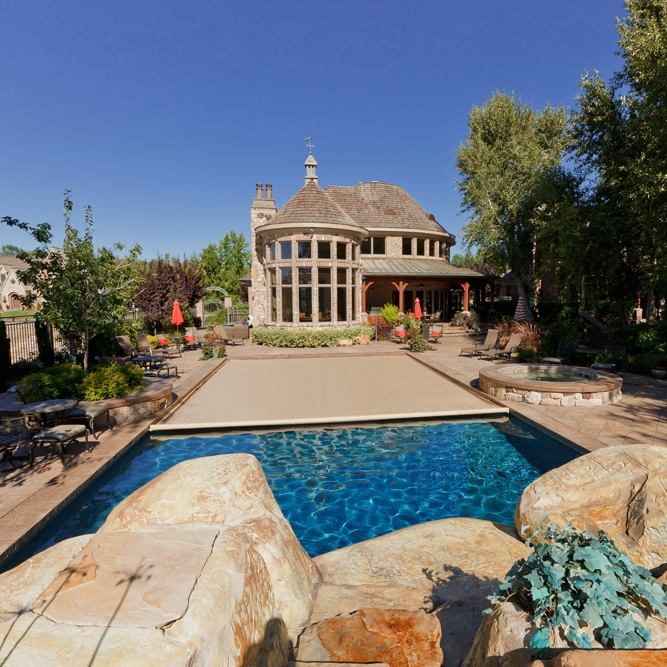
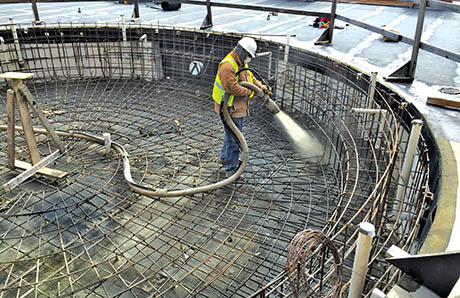
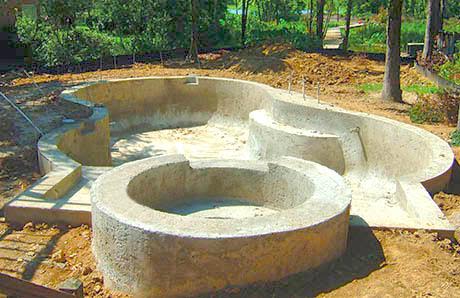
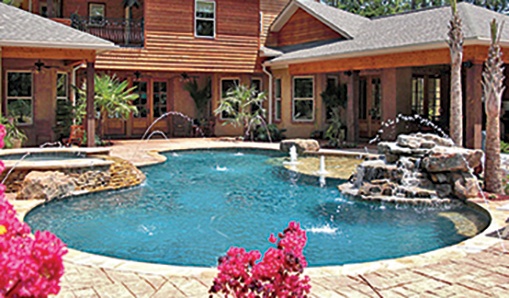
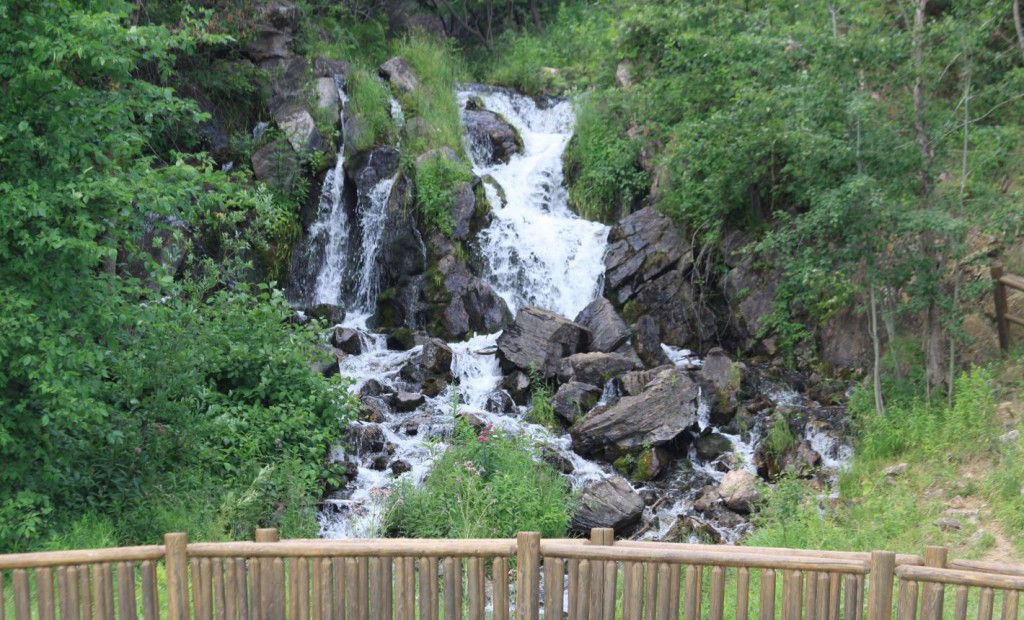

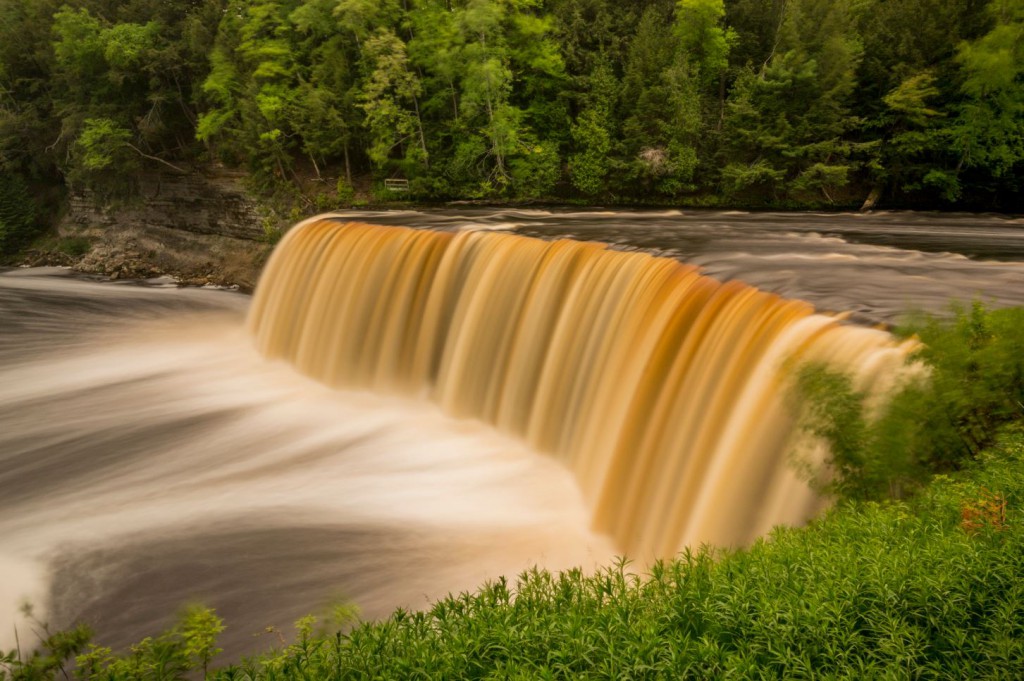
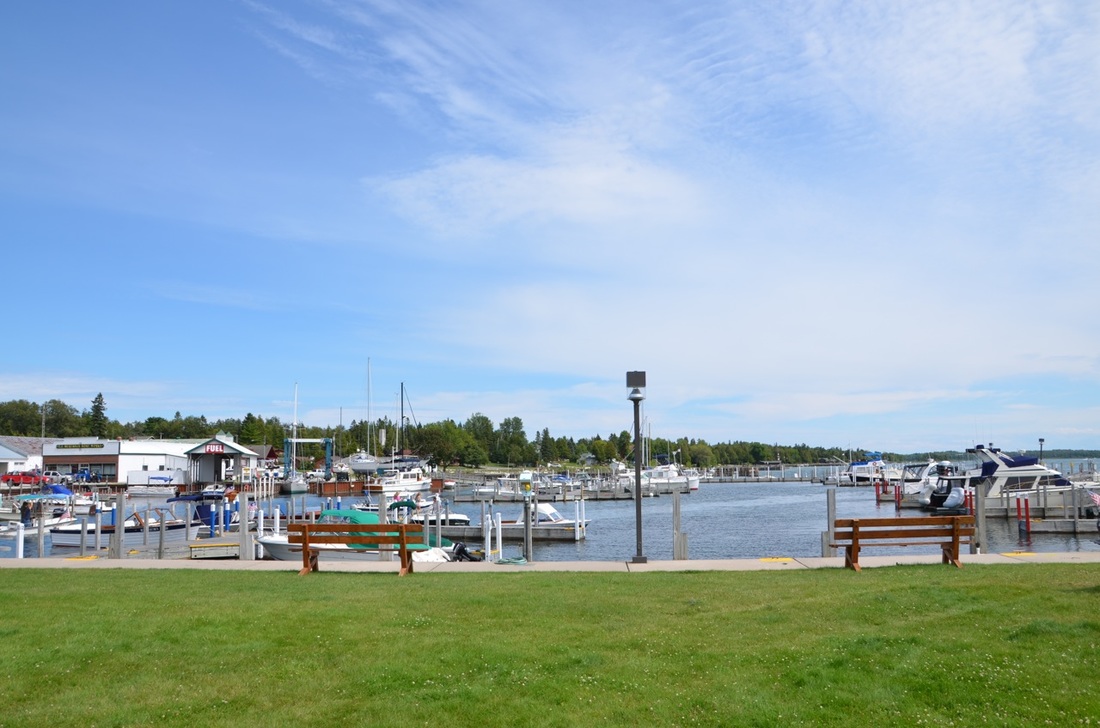
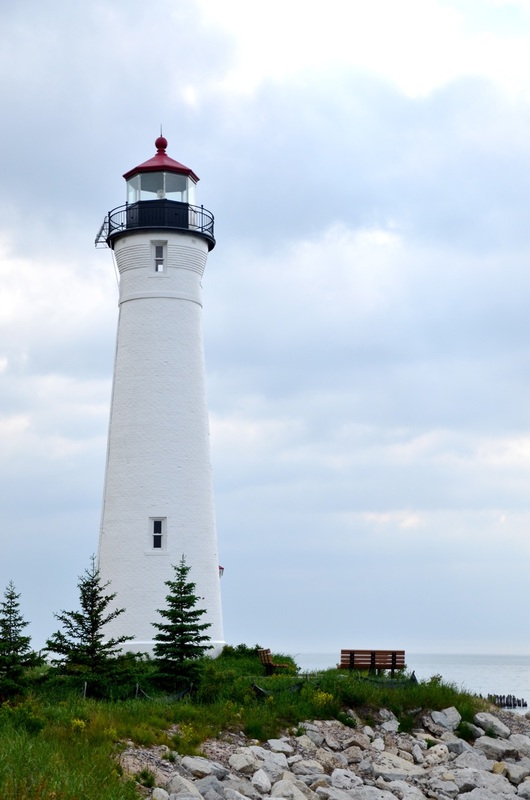
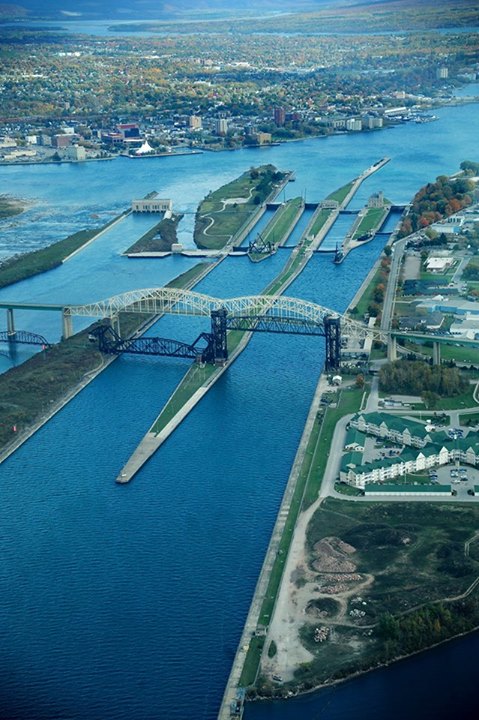

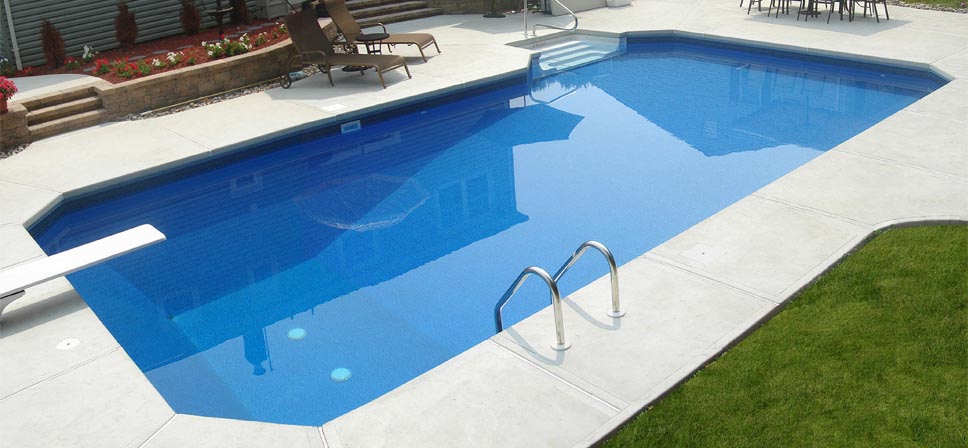
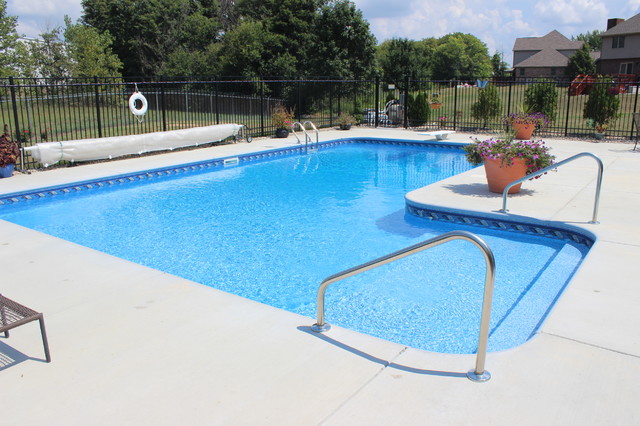
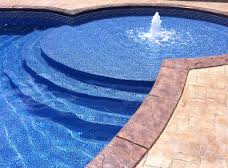

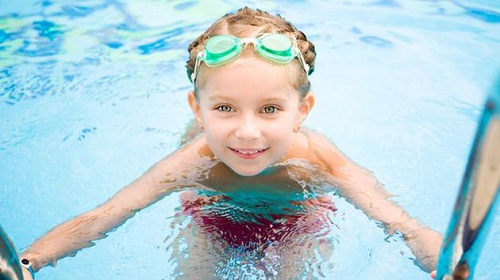
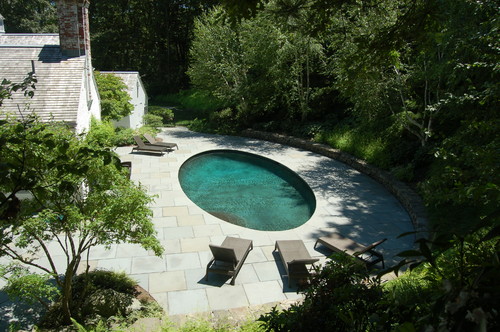
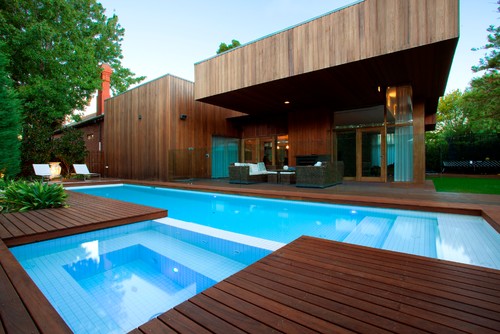
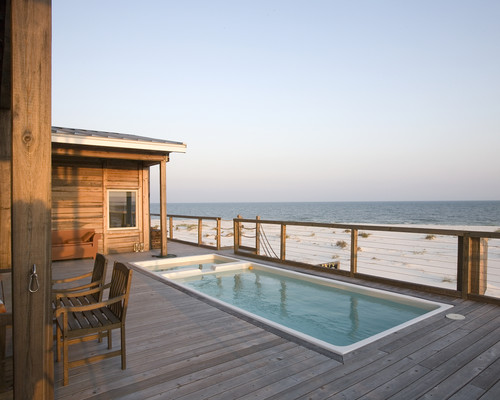
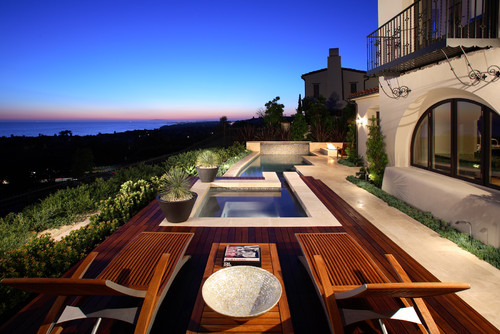


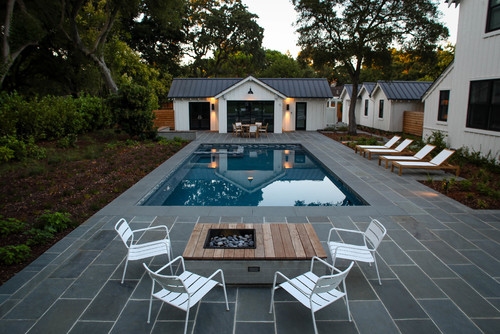

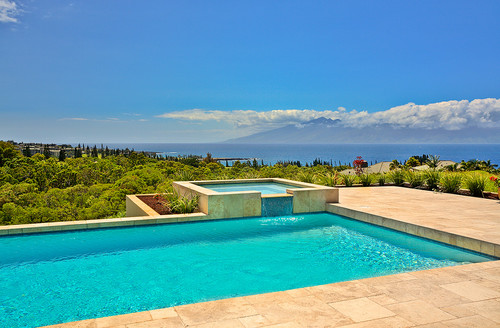

 RSS Feed
RSS Feed

